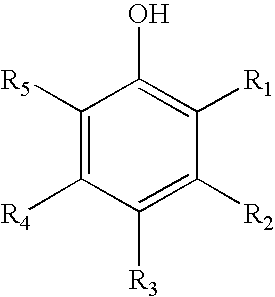Antimicrobial hand wash formulations
a technology of antimicrobial and hand wash, which is applied in the direction of detergent compositions, cosmetics, make-up, etc., can solve the problems of affecting the final hand wash, anionics and non-ionics also tend to not interact well with the active ingredients, and high price of amphoterics and amine oxides, so as to reduce skin irritation and total solids
- Summary
- Abstract
- Description
- Claims
- Application Information
AI Technical Summary
Benefits of technology
Problems solved by technology
Method used
Image
Examples
example one
[0033]The use of amphoteric surfactants in antimicrobial hand washes containing triclosan, and / or p-chloro-m-xylenol, is a rarity because these amphoteric surfactants normally deactivate the active ingredients. Unexpectedly, it has been found that there are a few amphoteric surfactants, more specifically zwitterionic surfactants, that do not inhibit the antimicrobial properties of the active ingredient. The following sample creation and testing will demonstrate this discovery.
[0034]Multiple hand wash test samples were made in accordance with the formulation provided directly below, wherein the zwitterionic surfactant was changed for each sample. The zwitterionic surfactants employed, as well as the efficacy of the resultant hand wash in reducing Escherichia coli, are reflected in Table 1. The process for making the samples was as follows: the active ingredient was added to the surfactant and mixed until all of the solid active ingredient dissolved into the surfactant. If required, h...
example two
[0036]The efficacy of a particular hand wash in accordance with this invention was tested against multiple microorganisms and strains thereof. The organisms tested varied greatly, including bacterial, yeast and fungal species, and are of the type most commonly found in settings where clean, sanitized hands are most desired. The test procedure was as follows: the hand wash was diluted to 99% volume / volume of the original concentration, and this new sample was then added to a second solution containing the microorganism to be tested. This inoculation occurred at 15 and 30 seconds. The samples were then plated onto agar plates and incubated. The log reduction was calculated by comparing the values between a non-inoculated sample and the sample inoculated with the hand wash.
The hand wash contained the following ingredients:
ChemicalAmountProcessed Waterq.s. to 100Dipropylene Glycol3.0 gHuntsman (DipropyleneGlycol-LO)Triclosan0.3 gCiba Specalities(Irgasan DP300)PEG-5 Oleammonium0.7 gAbite...
example three
[0038]As disclosed, hand washes made in accordance with the particularly preferred embodiments of this invention have a reduced level of solids. To show this, the solids content of the hand wash formulation of Example Two, above, was compared with competitive antimicrobial hand washes. Competitive antimicrobial hand washes were tested for solids content by placing a weighed sample into a 50° C. oven for 48 hours to ensure all the volatile components were removed. After the 48 hours the samples were removed from the oven and allowed to cool to room temperature. Then the samples were weighed a second time and the percent solids calculated from the two values.
Percentsolids=1-(MassStart-MassLeft)MassStart
TABLE THREEHand WashPercent Solids (% w / w)Dial Complete - Foaming Hand Wash27.96Dial Complete - HCPHW31.88Flora Free15.50Acute-Kare12.86Foam Care12.68Bacti-Stat16.27Medi-Scrub17.74Bacti-Foam15.70Endure 25018.74Keystone18.62Average:18.95
[0039]The total solids amount of the hand wash of E...
PUM
| Property | Measurement | Unit |
|---|---|---|
| weight % | aaaaa | aaaaa |
| wt % | aaaaa | aaaaa |
| wt % | aaaaa | aaaaa |
Abstract
Description
Claims
Application Information
 Login to View More
Login to View More - R&D
- Intellectual Property
- Life Sciences
- Materials
- Tech Scout
- Unparalleled Data Quality
- Higher Quality Content
- 60% Fewer Hallucinations
Browse by: Latest US Patents, China's latest patents, Technical Efficacy Thesaurus, Application Domain, Technology Topic, Popular Technical Reports.
© 2025 PatSnap. All rights reserved.Legal|Privacy policy|Modern Slavery Act Transparency Statement|Sitemap|About US| Contact US: help@patsnap.com



